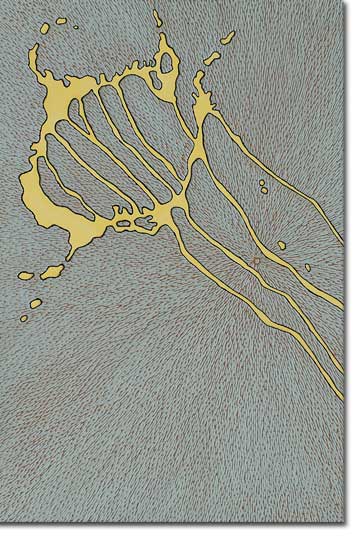joe
thurston
april 2007 by richard speer
 “Making anxiety beautiful” is how Joe Thurston boils down
his modus operandi as an abstract painter. The Portland-based
artist, who has a show at Elizabeth Leach in August, says he’s
“trying to get to the bottom of deeply based, primal anxieties
about scary things like viruses and global warming and
colliding galaxies.” In his gestural paintings on carved
panel, Thurston explores the perverse attraction of nature’s
menacing aspect. His fearsomely beautiful centrifugal
splatters reference monster hurricanes spawned by climate
change; his branching vines imply both the life-sustaining
growth of plants and the malignant growth of cancerous
tumors.
“Making anxiety beautiful” is how Joe Thurston boils down
his modus operandi as an abstract painter. The Portland-based
artist, who has a show at Elizabeth Leach in August, says he’s
“trying to get to the bottom of deeply based, primal anxieties
about scary things like viruses and global warming and
colliding galaxies.” In his gestural paintings on carved
panel, Thurston explores the perverse attraction of nature’s
menacing aspect. His fearsomely beautiful centrifugal
splatters reference monster hurricanes spawned by climate
change; his branching vines imply both the life-sustaining
growth of plants and the malignant growth of cancerous
tumors.
For 10 years, Thurston made a name for himself
throughout the Northwest with his unsettling portraits of
women, painted in an X-ray-vision style that peered through
his subjects’ skin, exposing their musculature and,
metaphorically, their deepest insecurities and fears. It was a
distinctive, harrowing style, but one that Thurston eventually
felt had run its course. “Not to sound overly spiritual,” he
says, “but at a certain point I was looking for something more
organic, something in the deeper matrix of the world.” A
conversation with a friend about printmaking and an online
study of the Luttrell Psalter, a 14th century illuminated
manuscript, eventually led the artist to draw scroll- and
vine-like motifs onto linoleum blocks, later carving the
shapes into the surface such that they stood out in relief to
the picture plane. “It felt good in my wrist,” he says of the
twisty, meandering motifs. “It was like the fiddlehead ferns
that grow around my house. My wife and I started calling it
‘the squiggle.’” The whimsical moniker belied the more
sinister undercurrents Thurston saw in the gesture, which
reminded him of tendrils, tentacles, neurons, and cancers.
Eventually the squiggle mutated into drips and splatters,
which he saw micro-and macrocosmically as virus-and
hurricane-like forces. “What I’m after is the interior and
exterior at the same time: things happening in the body and
things happening in the universe.”
The process he
developed in 2006 to accomplish this end begins with intuitive
shapes that he splashes on the panel and subsequently traces
in graphite. After wiping the block clean, he painstakingly
carves each of the splatters into the panel. In the background
he carves a dizzying, mandala-like field that radiates from a
central vanishing point. “I think of the background as a net
holding the shapes up—or to borrow a phrase from Hélène
Cixous, ‘a matrix for meaning to form on.’” Next, Thurston
paints the background and shapes in acrylic paint, sometimes
in dramatically contrasting colors that pop and preen: hot
pink, candy-apple green; other times in subtler shades: peach,
forest green, pumpkin. He finishes the process by outlining
the splatters in black, giving them a cartoony finish. These
outlines superimpose a kind of Pop feel atop an Abstract
Expressionist base, recalling Roy Lichtenstein’s Brushstrokes
series in the mid-1960s. Like Lichtenstein’s, Thurston’s works
are at once reverential of the past while also wryly distanced
from it. Despite the microbiologic and environmental bogeymen
they spring from in the artist’s mind, the finished paintings
emanate a gee-whiz exuberance owing to their juxtaposition of
spontaneous painterly gesture and time- and craft-intensive
carving. In facing his primordial fears, Thurston has
developed a formal language limited only by the permutations
of gesture and color—which is to say, one that is boundless.
Joe Thurston’s work will be on display this August
at Elizabeth Leach Gallery, 417 NW 9th Ave., in Portland. For
more information (503) 224-0521
Apr 2007 by richard speer
|
top of page |
|



